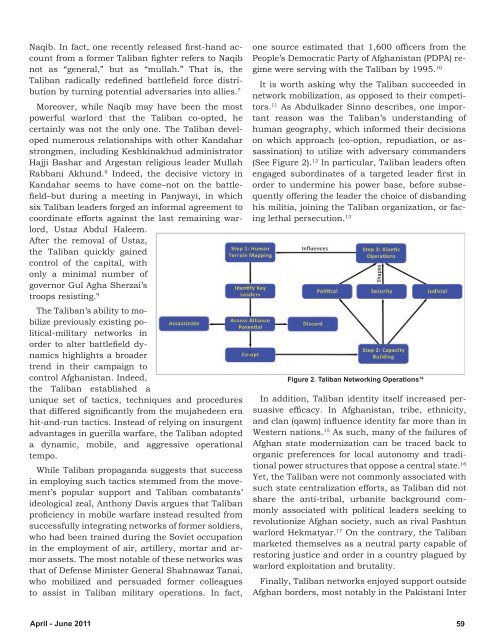George w. casey jr. - Federation of American Scientists
George w. casey jr. - Federation of American Scientists
George w. casey jr. - Federation of American Scientists
Create successful ePaper yourself
Turn your PDF publications into a flip-book with our unique Google optimized e-Paper software.
Naqib. In fact, one recently released first-hand account<br />
from a former Taliban fighter refers to Naqib<br />
not as “general,” but as “mullah.” That is, the<br />
Taliban radically redefined battlefield force distribution<br />
by turning potential adversaries into allies. 7<br />
Moreover, while Naqib may have been the most<br />
powerful warlord that the Taliban co-opted, he<br />
certainly was not the only one. The Taliban developed<br />
numerous relationships with other Kandahar<br />
strongmen, including Keshkinakhud administrator<br />
Hajji Bashar and Argestan religious leader Mullah<br />
Rabbani Akhund. 8 Indeed, the decisive victory in<br />
Kandahar seems to have come–not on the battlefield–but<br />
during a meeting in Panjwayi, in which<br />
six Taliban leaders forged an informal agreement to<br />
coordinate efforts against the last remaining warlord,<br />
Ustaz Abdul Haleem.<br />
After the removal <strong>of</strong> Ustaz,<br />
the Taliban quickly gained<br />
control <strong>of</strong> the capital, with<br />
only a minimal number <strong>of</strong><br />
governor Gul Agha Sherzai’s<br />
troops resisting. 9<br />
The Taliban’s ability to mobilize<br />
previously existing political-military<br />
networks in<br />
order to alter battlefield dynamics<br />
highlights a broader<br />
trend in their campaign to<br />
control Afghanistan. Indeed,<br />
the Taliban established a<br />
unique set <strong>of</strong> tactics, techniques and procedures<br />
that differed significantly from the mujahedeen era<br />
hit-and-run tactics. Instead <strong>of</strong> relying on insurgent<br />
advantages in guerilla warfare, the Taliban adopted<br />
a dynamic, mobile, and aggressive operational<br />
tempo.<br />
While Taliban propaganda suggests that success<br />
in employing such tactics stemmed from the movement’s<br />
popular support and Taliban combatants’<br />
ideological zeal, Anthony Davis argues that Taliban<br />
pr<strong>of</strong>iciency in mobile warfare instead resulted from<br />
successfully integrating networks <strong>of</strong> former soldiers,<br />
who had been trained during the Soviet occupation<br />
in the employment <strong>of</strong> air, artillery, mortar and armor<br />
assets. The most notable <strong>of</strong> these networks was<br />
that <strong>of</strong> Defense Minister General Shahnawaz Tanai,<br />
who mobilized and persuaded former colleagues<br />
to assist in Taliban military operations. In fact,<br />
one source estimated that 1,600 <strong>of</strong>ficers from the<br />
People’s Democratic Party <strong>of</strong> Afghanistan (PDPA) regime<br />
were serving with the Taliban by 1995. 10<br />
It is worth asking why the Taliban succeeded in<br />
network mobilization, as opposed to their competitors.<br />
11 As Abdulkader Sinno describes, one important<br />
reason was the Taliban’s understanding <strong>of</strong><br />
human geography, which informed their decisions<br />
on which approach (co-option, repudiation, or assassination)<br />
to utilize with adversary commanders<br />
(See Figure 2). 12 In particular, Taliban leaders <strong>of</strong>ten<br />
engaged subordinates <strong>of</strong> a targeted leader first in<br />
order to undermine his power base, before subsequently<br />
<strong>of</strong>fering the leader the choice <strong>of</strong> disbanding<br />
his militia, joining the Taliban organization, or facing<br />
lethal persecution. 13<br />
Figure 2. Taliban Networking Operations 14<br />
In addition, Taliban identity itself increased persuasive<br />
efficacy. In Afghanistan, tribe, ethnicity,<br />
and clan (qawm) influence identity far more than in<br />
Western nations. 15 As such, many <strong>of</strong> the failures <strong>of</strong><br />
Afghan state modernization can be traced back to<br />
organic preferences for local autonomy and traditional<br />
power structures that oppose a central state. 16<br />
Yet, the Taliban were not commonly associated with<br />
such state centralization efforts, as Taliban did not<br />
share the anti-tribal, urbanite background commonly<br />
associated with political leaders seeking to<br />
revolutionize Afghan society, such as rival Pashtun<br />
warlord Hekmatyar. 17 On the contrary, the Taliban<br />
marketed themselves as a neutral party capable <strong>of</strong><br />
restoring justice and order in a country plagued by<br />
warlord exploitation and brutality.<br />
Finally, Taliban networks enjoyed support outside<br />
Afghan borders, most notably in the Pakistani Inter<br />
April - June 2011 59















